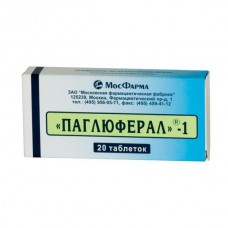Expiration date: 06/2026
Structure and Composition
Pagluferalum 1. One tablet contains:
phenobarbital 0.025 g,
bromisoval 0.1 g,
Caffeine sodium benzoate 0.0075 g,
papaverine gidrohorid 0.015 g,
Calcium gluconate 0.25 g
Pagluferalum 2. One tablet contains:
phenobarbital 0.035 g,
bromisoval 0.1 g,
Caffeine sodium benzoate 0.0075 g,
papaverine gidrohorid 0.015 g,
Calcium gluconate 0.25 g
Pagluferalum 3. One tablet contains:
0.05 g of phenobarbital,
bromisoval 0.15 g,
caffeine-sodium benzoate 0.01 g
papaverine gidrohorid 0.02 g,
Calcium gluconate 0.25 g
10 pieces. in blisters in cardboard pack 2 packs.
Pharmacological action: antiepileptic, sedative.
pharmacodynamics
Phenobarbital has sedative, hypnotic, antispasmodic, anticonvulsant and central muscle relaxant effect. Sensitizing GABA neurotransmitter receptor opens the ion channel and for chlorine increases their delivery into nerve cells. It improves blood perfusion in the ischemic areas of the brain. It reduces the need for CNS oxygen.
Bromisoval has a sedative and mild hypnotic effect.
Caffeine blocks the central and peripheral adenosine receptors inhibits phosphodiesterase activity, contributes to stabilizing the transmission of nerve impulses. It regulates and strengthens the processes of excitation in the cerebral cortex, respiratory and vasomotor centers, activates reflexes and motor activity, providing a direct stimulating effect on the central nervous system. It improves mental and physical performance, stimulates mental activity, shortens the reaction time, temporarily reduces fatigue and drowsiness. Quickens and deepens breathing, increases the contractile activity of the myocardium, the heart rate and blood pressure during hypotension, dilates the bronchi, biliary tract, arterioles in skeletal muscle, heart, kidney, reduces platelet aggregation, moderate increases diuresis, stimulates the secretion of gastric glands, increases basal metabolism, enhances glycogenolysis ( causing hyperglycemia).
Papaverine, inhibiting phosphodiesterase and causing the accumulation of cAMP in the cells, reduces the tone and relaxes the smooth muscles of internal organs (gastrointestinal tract, respiratory and urogenital systems) and vessels. It has antispasmodic effect myotropic has antihypertensive properties. In high doses, it reduces the excitability of cardiac muscle conductivity and slows intracardiac and causes sedation.
Calcium gluconate fills a deficiency of calcium in the body. Calcium ions are required for nerve impulse transmission process, reduction of skeletal and smooth muscles, myocardial activity, bone formation, blood coagulation. Calcium reduces vascular permeability and the cells prevents the development of inflammatory response.
Pharmacokinetics
The ingestion of caffeine is well absorbed throughout the intestine. Cmax - 1,58-1,76 mg / l. T1 / 2 -. 3,9-5,3 hours Biotransformiroetsa in the liver to form a 5 metabolites are eliminated in the urine.
Phenobarbital ingestion completely absorbed slowly. The time to reach Cmax - 1-2 hours, connection with blood plasma proteins - 50%. It is metabolized in the liver, induces hepatic microsomal enzymes (the rate of enzymatic reactions is increased 10-12 times). Cumulate. T1 / 2 - 3-4 days. Excretion - the kidneys.
Indications: Epilepsy.
Contraindications
Hypersensitivity to the drug. Renal and hepatic insufficiency, acute porphyria, angle-closure glaucoma, organic diseases of the cardiovascular system (including atherosclerosis), AV blockade, respiratory failure, hypertension, sleep disturbance, irritability, advanced age (the risk of hyperthermia), hypercalcaemia , hypercoagulation, taking digitalis drugs for children under the age of 2 years.
Dosing and Administration
Inside, after eating, according to Table 2-4. at the reception (for adults), the maximum daily dose - 10 table, the children -. 1 / 2-1 Table. at the reception, the maximum dose for children up to 10 years - 5 Table. per day.
Side effects
Excitation or CNS depression, asthenic syndrome, ataxia, irritability, anxiety, insomnia or drowsiness, increased blood pressure, tachycardia, AV block, arrhythmia (including ventricular premature beats), nausea, vomiting, constipation, increased activity of hepatic transaminases, dysarthria , allergic reactions (skin rash, angioedema), eosinophilia.
With prolonged use - nausea, vomiting, skin rash, impaired motor coordination, drug dependence, the development of tolerance to bromizovalu.
Interaction
Interactions caused by phenobarbital: sedative and hypnotic effects of pentobarbital reduced while taking atropine, belladonna extract, glucose, thiamine, niacin, and psychoactive analeptikov funds. When combined with reserpine anticonvulsant effect decreases under the influence of amitriptyline, nialamidom, diazepam, chlordiazepoxide - is enhanced. It reduces the antibacterial activity of antibiotics and sulfonamides, anti-fungal effect of griseofulvin. When combined with drugs metabolized in the liver by oxidation, it accelerates the conversion of the latter and reduces their effectiveness.
Interactions due to papaverine: reduces the effect dopegita, efficiency is reduced by smoking.
Interactions due to caffeine: reduces the effect of narcotic and hypnotic drugs, increases - non-narcotic analgesics.
Overdose
Diplopia, weakness, drowsiness or restlessness.
special instructions
Patients with minor hypercalciuria, decreased glomerular filtration or with a history of nephrolithiasis Pagluferalum assignment should be carried out with care and under the control of calcium in the urine, due to the presence of calcium gluconate as part of the preparation. At the time of treatment should avoid work that requires concentration and speed of psychomotor reactions, not to take alcohol and drunie agents which inhibit the central nervous system activity.
Storage: List B. In dry, dark place.
Shelf life: 2 years




